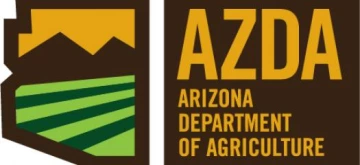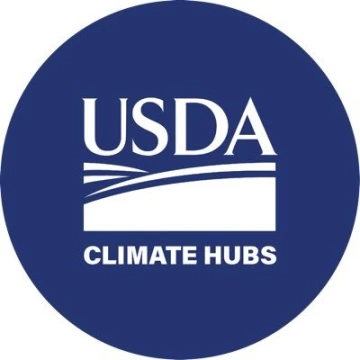< Back to Climate Viticulture Newsletter
Hello, everyone!
This is the June 2023 issue of the Climate Viticulture Newsletter – a quick look at some timely climate topics relevant to wine grape growing in Arizona.
May Recap | June Outlook | Growing Season Heat Accumulation | Extra Notes
A Recap of May Temperature and Precipitation
Monthly average temperatures were within 2 °F of the 1991-2020 normal for almost all of Arizona (light blue, white, and light orange areas on map), including all of the Verde Valley and Willcox AVAs and the eastern and western parts of the Sonoita AVA. For the few areas that weren’t, temperatures were either 2 to 4 °F below normal (blue and dark blue areas on map), like the central part of the Sonoita AVA, or 2 to 4 °F above normal (orange and dark orange areas on map). For reference, monthly temperatures in May last year were within 2 °F of normal for much of the western half of the state, and 2 to 4 °F above normal for much of the eastern half.
Area-average maximum and minimum temperatures during May 2023 were 80.7 and 47.5 °F for the Sonoita AVA, 83.5 and 49.9 °F for the Verde Valley AVA, and 83.9 and 48.7 °F for the Willcox AVA. Respective May normals are 81.7 and 49.6 °F, 84.5 and 50.0 °F, and 84.8 and 48.9 °F.
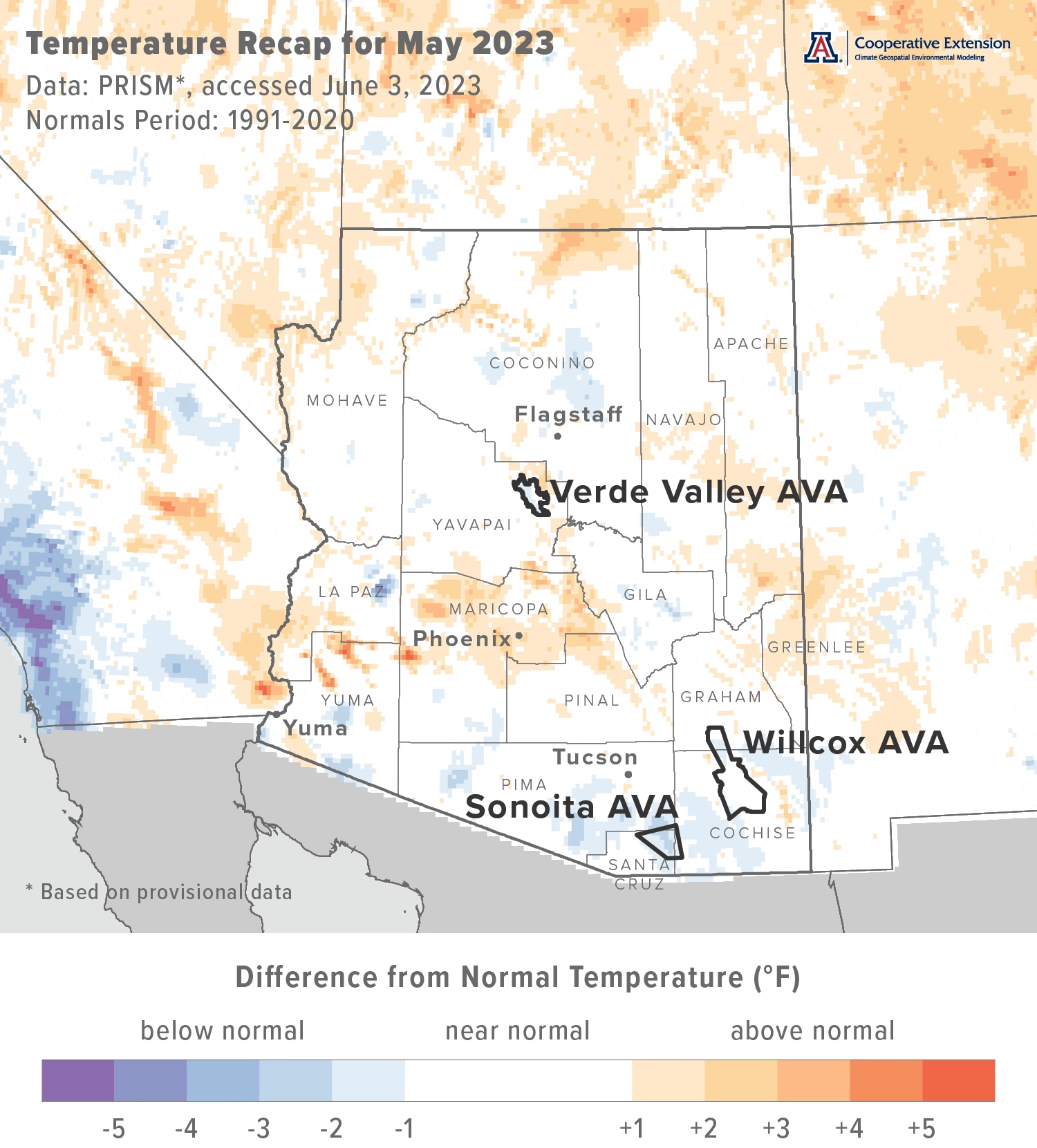
Jeremy Weiss
Monthly precipitation totals were more than 150 % of normal for many areas in the west-central and southeastern parts of the state (aqua, dark aqua, light blue, blue, and dark blue areas on map), including much of the Verde Valley and Willcox AVAs. Otherwise, and apart from much of the southwestern and south-central parts of the state that measured amounts below 50 % of normal (yellow and dark yellow areas on map), monthly totals mostly were near normal (white areas on map), including for the Sonoita AVA. Precipitation during May last year was less than 5 % of normal for almost all of Arizona.
Area-average total precipitation in May 2023 was 0.22 inches for the Sonoita AVA, 0.75 inches for the Verde Valley AVA, and 0.44 inches for the Willcox AVA. Respective May normals are 0.22, 0.44, and 0.29 inches.
Based on the daily weather summaries for the AZMet Bonita and Willcox Bench stations in the Willcox AVA, total reference evapotranspiration values last month bring growing season totals to 14.4 and 15.3 inches, respectively. Total precipitation, in contrast and all of which fell in mid-May, is 0.06 and 0.17 inches, respectively.
Although clearly not enough to cover irrigation demands, we’re unclear about whether the rain last month was enough to increase disease pressure of pathogens like powdery mildew or contribute to shatter or shedding of young berries from clusters. Despite shatter having a bad reputation for reducing yields, it might have a good side for tight-cluster varieties in Arizona, if not excessive. Once we get to the typically rainier months of July and August and rot in ripening berries becomes an issue, such varieties would have a better chance of drying out after monsoon storms and limiting any such losses. Please let us know if the May rain made for uncommon effects in your vineyard at this time of year.
Dig into daily weather summaries from 2023 for the AZMet Bonita and Willcox Bench stations in the Willcox AVA
Learn more about PRISM climate data
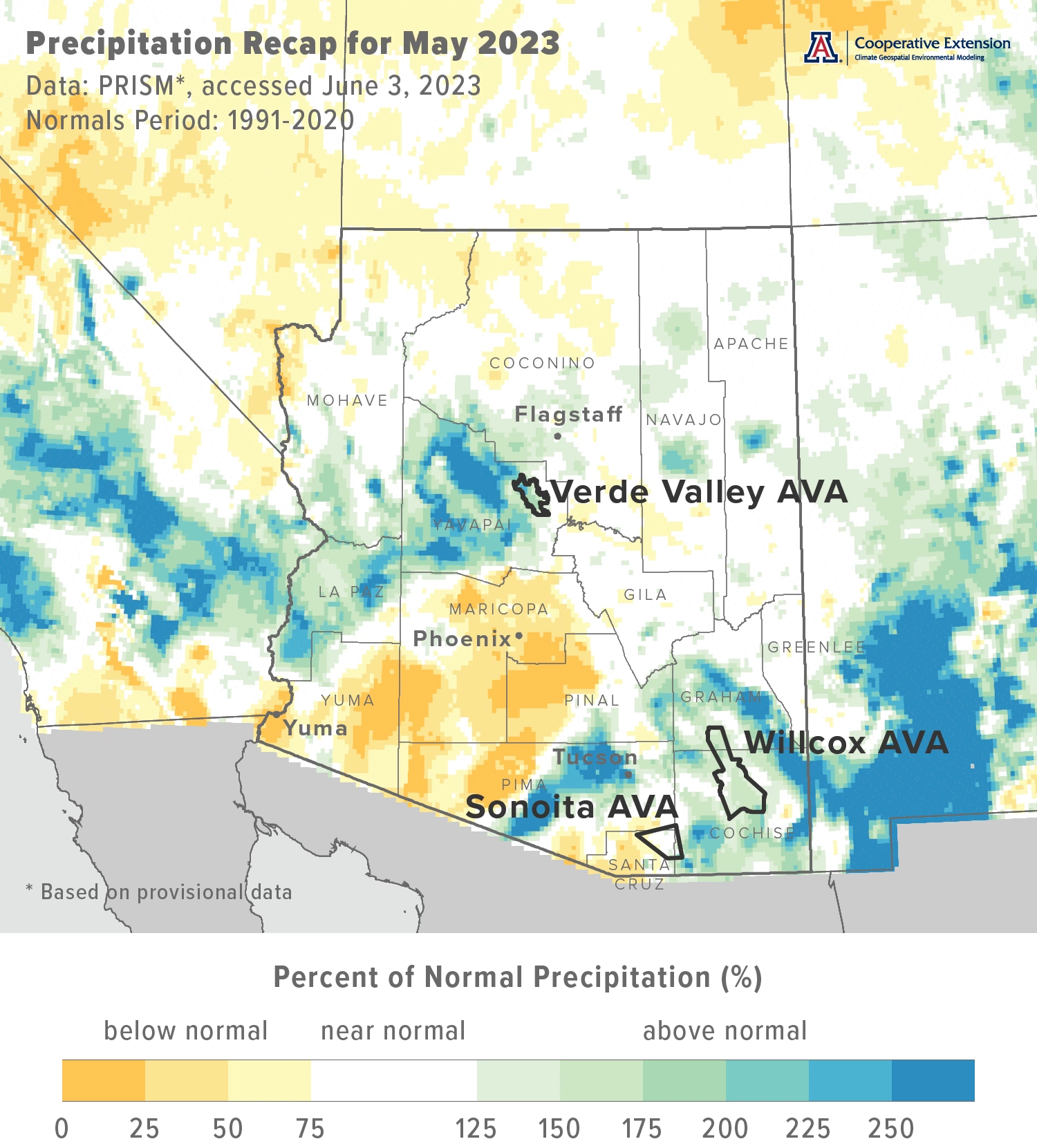
Jeremy Weiss
The Outlook for June Temperature and Precipitation
Temperatures over the course of this month have a slight increase in chances for being below the 1991-2020 normal across the entire state (light blue and blue areas on map). Monthly temperatures in June last year were up to 2 °F warmer than normal in parts of southeastern and north-central Arizona, including the three Arizona AVAs. Otherwise, temperatures were 2 to 4 °F above normal.
Area-average maximum and minimum temperatures during June 2022 were 90.5 and 61.1 °F for the Sonoita AVA, 97.2 and 61.1 °F for the Verde Valley AVA, and 93.5 and 62.0 °F for the Willcox AVA. Respective June normals are 90.6 and 59.0 °F, 95.4 and 58.4 °F, and 94.5 and 59.1 °F.
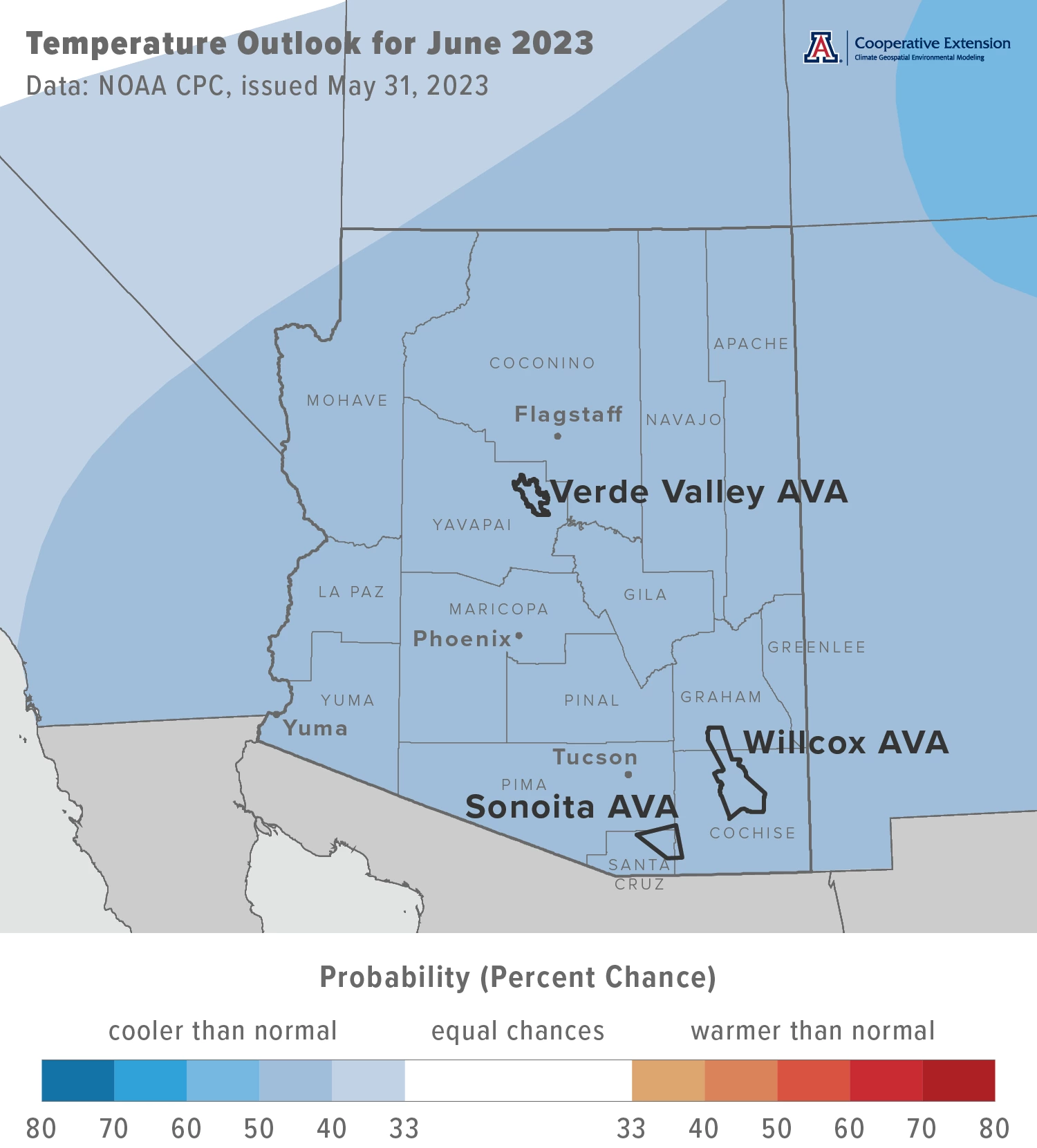
Jeremy Weiss
Precipitation totals for this month have equal chances for being below, near, or above normal for all of Arizona (white area on map). A relatively early start to the monsoon during June 2022 led to precipitation totals that were more than 200 % of normal for most of the state.
Despite the somewhat eye-popping percentages, area-average precipitation totals in June 2022 only were 1.28 inches for the Sonoita AVA, 0.73 inches for the Verde Valley AVA, and 1.59 inches for the Willcox AVA, as June normally is a relatively dry month. Respective June normals are 0.55, 0.18, and 0.42 inches.
At least a few things are clouding up forecasts of when the monsoon generally might start this year and relatively how much rain it might bring. One is the above-normal snowpack and soil moisture levels in the Four Corners and southern Rocky Mountains region. Such conditions have coincided with late monsoon starts in the past. Another is what looks to be an impending El Niño event, which is likely to form this summer and have a greater than 90 % chance of persisting into the winter. We’ll keep an eye on this over the coming months. And another is a moderate increase in chances this year for above-normal hurricane activity in the eastern Pacific Ocean. As we know, tropical cyclones that form to our south can be a source of moisture and rainfall for our region.
Like most other past years at this point in the growing season, we don’t know much about what the monsoon will deliver. We do, however, already know what the possible impacts to the vineyard are and which varieties are more affected, regardless of which temperature and precipitation conditions appear over the next few months. Impacts from 2020, 2021, and 2022 represent the current range. As mentioned in our talk at the Arizona viticulture summit in early March, monsoon hedging is one way to modify exposure to and lessen the magnitude of such impacts. Some hedges in the vineyard are having early and late varieties, varieties that hold pH under hot conditions, and varieties that are resistant to rot under wet conditions. Some hedges in the winery are being able to switch between varietal wines and blends, and between early-pick sparkling and normal- to late-pick table wines. The idea is to have a variety lineup and enough adaptability in the winery to limit losses from unfavorable conditions that occur during ripening and harvest. We might be biased, but we think the monsoon makes the vintage. Monsoon hedging helps ensure that it’ll be a good one overall.
To stay informed of long-range temperature and precipitation possibilities beyond the coverage of a standard weather forecast, check in, too, with the six-to-ten-day outlook and eight-to-fourteen-day outlook issued daily by NOAA’s Climate Prediction Center.
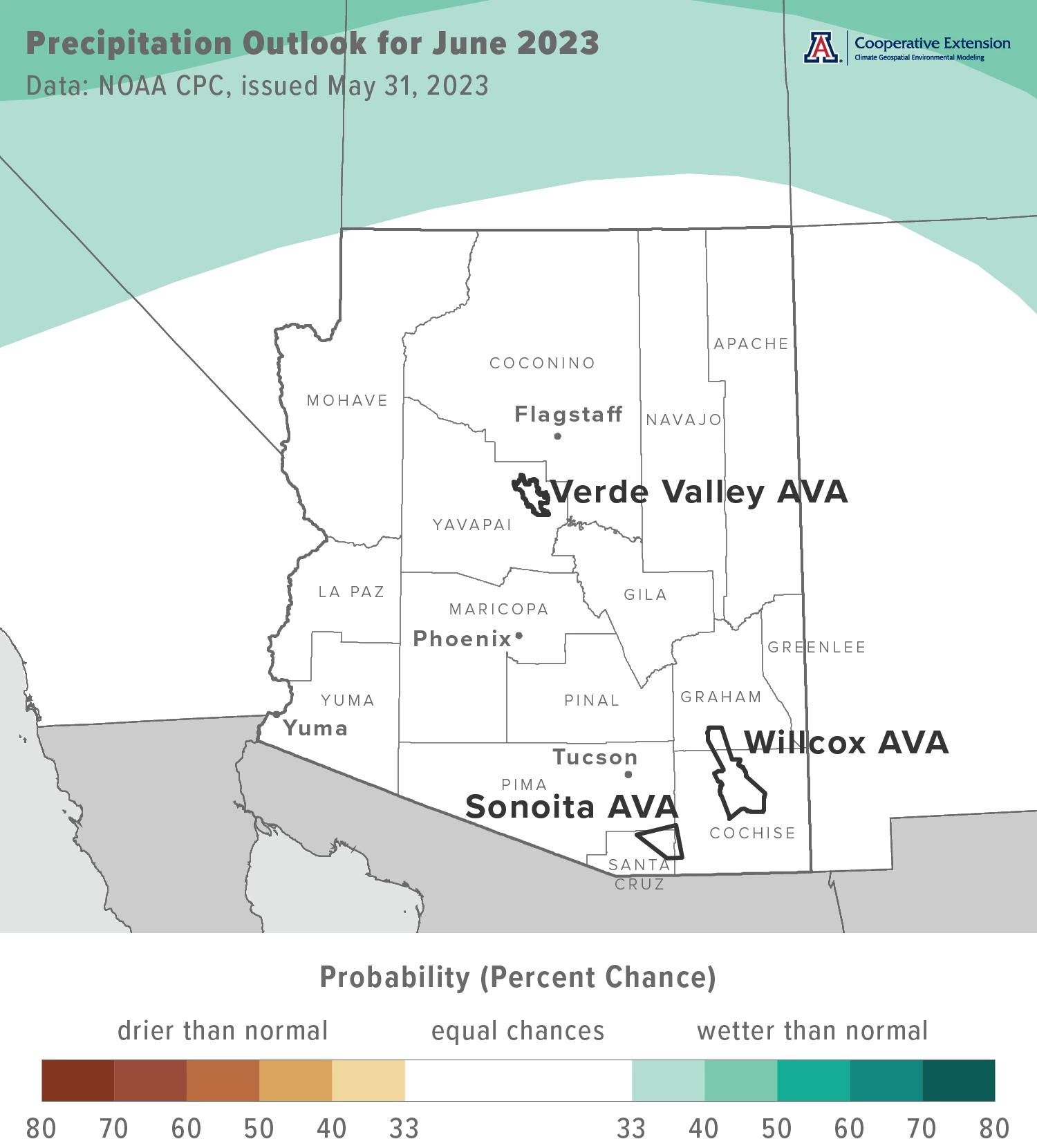
Jeremy Weiss
Heat Accumulation during the Growing Season
Heat accumulation from April through May this year for the AZMet Bonita and Willcox Bench stations (blue bars on graph) is less than what it was at this time last year. This suggests that vine growth rates and time between pre-veraison growth stages may have been slower and longer so far this growing season than what they were in the previous one. Also, heat accumulation is greater at AZMet Willcox Bench than at AZMet Bonita, suggesting that a given variety in the south-central part of the Willcox AVA is at a more advanced growth stage than in the northern part, all else equal. Over the past seven years, the least amount of heat accumulation for both locations at this point in the growing season happened in 2019, a result of temperatures in May that year being 4 to 8 °F below normal across much of the state.
Like last month, we’re using the Wang-Engel model to calculate heat accumulation, one that accounts for the slowdown or stoppage of vine photosynthesis and growth as temperatures surpass 95 °F. Although temperatures in the Willcox AVA last month weren’t that hot, this feature may come into play over the coming ones.
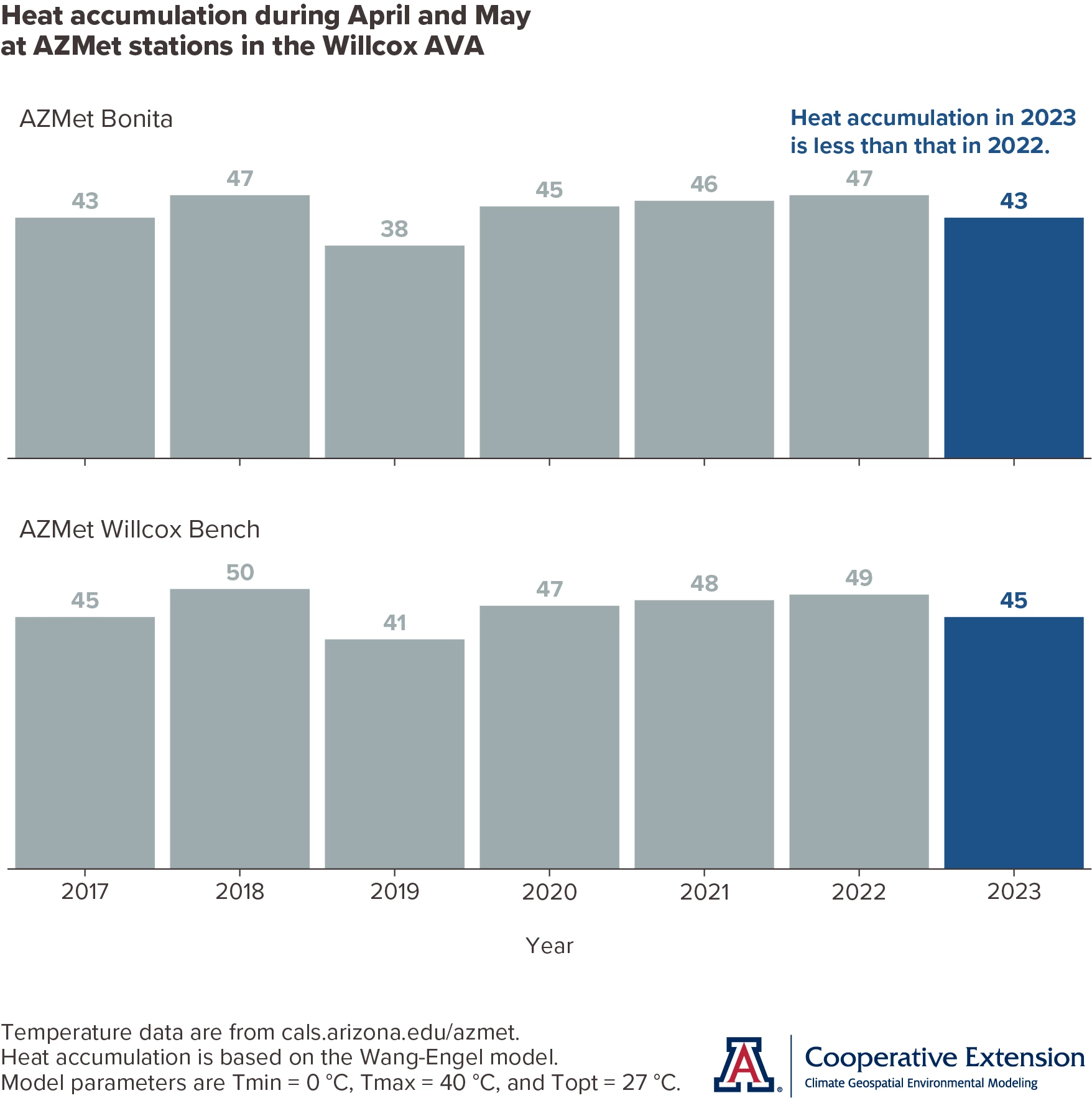
Jeremy Weiss
Extra Notes
The Water Resources Research Center at the University of Arizona recently published a Water Factsheet for Graham County, where the northern third of the Willcox AVA is. The factsheet includes topics like water supply and demand, irrigation efficiency, watershed restoration, and water reuse.
The Water Resources Research Center at the University of Arizona also recently published a Water Factsheet for Yavapai County, where the Verde Valley AVA is. The factsheet includes information on water supplies, demands, and management in contexts of agriculture, communities, and the natural environment.
Like last month, there is a below-normal potential this month for significant wildland fires across the northern half of Arizona. Across the southern half, potential is near normal.
For those of you in southeastern Arizona, including the Sonoita and Willcox AVAs, Cooperative Extension manages an email listserv in coordination with the Tucson forecast office of the National Weather Service to provide information in the days leading up to agriculturally important events, like heat waves and high-wind days. Please contact us if you'd like to sign up.
And for those of you in north-central and northeastern Arizona, including the Verde Valley AVA, Cooperative Extension also now manages an email listserv in coordination with the Flagstaff forecast office of the National Weather Service to provide similar information for this part of the state. Please contact us if you'd like to sign up.
Undergraduate students in the College of Agriculture and Life Sciences at the University of Arizona are looking for internships with businesses and companies in the viticulture and winery industries. Please contact Danielle Buhrow, Senior Academic Advisor and Graduate Program Coordinator in the Department of Agricultural and Resource Economics, for more information.
Please feel free to give us feedback on this issue of the Climate Viticulture Newsletter, suggestions on what to include more or less often, and ideas for new topics.
Did someone forward you this newsletter? Please contact us to subscribe.
Have a wonderful June!
With current and past support from:
